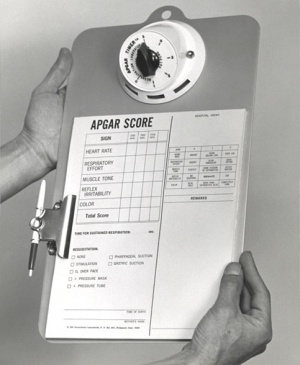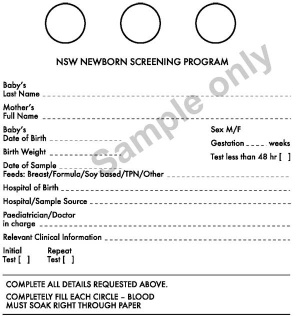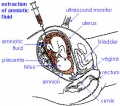Neonatal Diagnosis
Introduction
In the early 1950's Virginia Apgar published the research article that was the basis of a simple diagnostic test, the 10-point Apgar score, for neonatal well-being at birth that continues to be used today.
There are a number of different neonatal screening (newborn screening) programs in different countries testing for various "common" abnormalities and infections. In addition to the Gutherie test there are also physical tests for hip displasia and a growing number of countries testing of newborn hearing.
Neonatal Diagnosis Links: APGAR test | Guthrie test | Hearing test | Electrocardiogram (ECG/EKG) | Tandem mass spectrometry
Diagnosis Categories
- Prenatal diagnosis - number of different techniques (non-invasive, invasive) for determining normal development
- Neonatal diagnosis (APGAR test, Guthrie test)
- Maternal diagnosis - often pregnancy will expose maternal health problems
Apgar Test
A historic neonatal test designed by Dr Virginia Apgar used in nearly all maternity clinics to assess the newborn infants well being assigned scores for each of 5 indicators: Heart Rate, Respiratory Effort, Reflex Irritability, Muscle Tone, Colour Measured at one and five minutes after birth the Score values are totalled for all indicators: 7-10 is considered normal, 4-7 may require resuscitative measures, 3 and below require immediate resuscitation. In recent years there has been some controversy of the relevance and accuracy of some of the criteria used in this test, though many feel it is still an invaluable initial assessment tool particularly where medical services are limited.
- Measured at one and five minutes after birth.
- The Score values are totalled for all indicators
- 7 to 10 is considered normal
- 4 to 7 may require resuscitative measures
- 3 and below require immediate resuscitation
| Indicator | Score 0 | Score 1 | Score 2 |
| Activity (muscle tone) |
Limp; no movement | Some flexion of arms and legs | Active motion |
| Pulse (heart rate) |
No heart rate | Fewer than 100 beats per minute | At least 100 beats per minute |
| Grimace (reflex response) |
No response to airways being suctioned | Grimace during suctioning | Grimace and pull away, cough, or sneeze during suctioning |
| Appearance (color) |
The baby's whole body is completely bluish-gray or pale | Good color in body with bluish hands or feet | Good color all over |
| Respiration (breathing) |
Not breathing | Weak cry; may sound like whimpering, slow or irregular breathing | Good, strong cry; normal rate and effort of breathing |
- Links: Apgar test
Guthrie Test
A blood screening test developed by Dr Robert Guthrie (1916-95) at University of Buffalo. The test is carried out on neonatal (newborn) blood detecting markers for a variety of known disorders (phenylketonuria (PKU), hypothyroidism and cystic fibrosis). In NSW and Victoria, the Guthrie Cards are currently stored indefinitely.
Guthrie R, Susi A (September 1963). "A simple Phenylalanine method for detecting Phenylketonuria in large populations of newborn infants". Pediatrics 32: 338–43. PMID 14063511.
- Links: Guthrie test
Additional Images
- Gutherie card icon.jpg
Gutherie card
Routine Screened Disorders
Biotinidase Deficiency (OMIM)
Congenital Adrenal Hyperplasia (CAH) (OMIM)
Congenital Hypothyroidism (CH)
Congenital Toxoplasmosis
Cystic Fibrosis (CF) (OMIM)
Galactosemia (GAL) (OMIM)
Homocystinuria (OMIM)
Maple Syrup Urine Disease (MSUD) (MCAD | OMIM)
Medium-Chain Acyl-CoA Dehydrogenase Deficiency (MCAD) (OMIM)
Medium-Chain Acyl-CoA Dehydrogenase Deficiency (MCAD)
MCAD deficiency is the most common inherited disorder of mitochondrial fatty acid oxidation in people from northern Europe. It is characterized by an intolerance to prolonged fasting and an inability to generate energy during periods of increased energy demand. The disorder can be severe to fatal in infants.
The other disease characteristics include: recurrent episodes of hypoglycemic coma with medium-chain dicarboxylic aciduria, impaired ketogenesis, and low plasma and tissue carnitine levels.
Gutherie test detected autosomal recessive metabolic disease affects about one in 10 000 people (UK). This mitochondrial protein is encoded by a nuclear gene on chromosome 1 (Gene map locus 1p31) and has a common mutation (985A>G) with a carrier rate of around one in 65.2.
Tandem mass spectrometry
Tandem mass spectrometry (MS/MS) - can screen for PKU and many other diseases simultaneously (up to 21 metabolic diseases).[1]
Endocrine
Congenital Hypothyroidism
Neonates born with congenital hypothyroidism (CH) typically have a normal appearance and no detectable physical signs. Thyroid hormone is required for normal postnatal neural (cognitive) development with newborn screening and thyroid therapy able to be begun within 2 weeks of birth.
The availability of a universal screening program for this hormonal abnormality varies from country to country.[2]
Congenital hypothyroidism can occur through either dysgenesis or agenesis of the thyroid gland development or abnormal thyroid hormone production. A false positive high thyroid stimulating hormone (TSH) can occur, due to the neonatal TSH surge that elevates TSH levels and causes T4 and T3 changes in the first 1 or 2 days after birth.
See also Iodine deficiency.
Gene Tests
A new site developed by NIH "GeneTests" provides medical genetics information resources available at no cost to all interested persons. It contains educational information, a directory of genetic testing laboratories and links to other databases such as OMIM.
Links: Gene Tests
References
Search PubMed: neonatal diagnosis | neonatal screening
Glossary Links
- Glossary: A | B | C | D | E | F | G | H | I | J | K | L | M | N | O | P | Q | R | S | T | U | V | W | X | Y | Z | Numbers | Symbols | Term Link
Cite this page: Hill, M.A. (2024, May 2) Embryology Neonatal Diagnosis. Retrieved from https://embryology.med.unsw.edu.au/embryology/index.php/Neonatal_Diagnosis
- © Dr Mark Hill 2024, UNSW Embryology ISBN: 978 0 7334 2609 4 - UNSW CRICOS Provider Code No. 00098G







